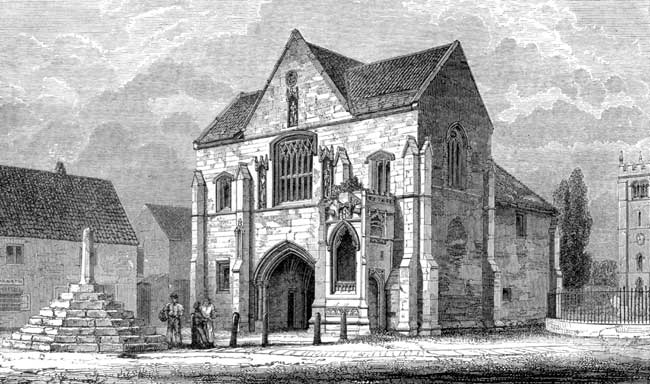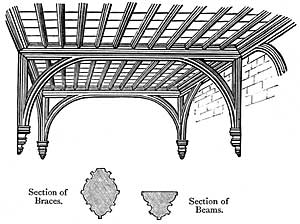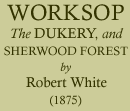< Previous | Contents | Next >
The priory gatehouse

Priory Gatehouse, Worksop.
History is entirely silent on the point as to when the Gatehouse of Worksop Priory was built, and by whom; we must therefore endeavour to make architecture supply the deficiency. For the most part the structure is of the Decorated period, and appears to have been erected in the first quarter of the 14th century, when the third Thomas de Furnival, lord of Worksop, was living; who, in the 24th Edward I., obtained the grant of holding a market and fair, of which the wide-spreading base of a cross close by is a pleasing reminiscence. We may, therefore, assume that this Lord Furnival, the then representative of the Priory founder, at least aided in the erection of its Gate-house, and perhaps in connection with the establishment of the above-named fair and market, which would render a gate-house to the Priory especially necessary. Externally, the southern and principal elevation of this feature is worthy of much admiration, from the general character and variety of its design. Four buttresses break up its monotony of surface; in the centre is the entrance archway, 12 feet wide, and above is a large fiat-arched transomed window of six lights, surmounted by quatre-foiled tracery; this is flanked by two richly canopied niches containing statues, the one on the east representing St. Cuthbert, the patron saint of the Priory, the other either St. Aidan, his early preceptor, or more probably St. Augustine, whose rule was observed at Worksop. In the gable above is another similar niche, filled with a statue; not of the Virgin and Child, as has been usually said, but of the first person of the Holy Trinity, holding a crucifix between His knees; and above this is a pretty little perforated circlet. The western elevation is in a ruinous condition. The northern one has a central gable, lit by a four-lighted transomed window, and supported by a lean-to on either side. There will be perceived a closed doorway, about 10 feet from the ground, once giving access to the upper rooms of the Gate-house by means of external stone steps up to that point. Another staircase still exists on the opposite side of the Gate-house, provided with a protecting porch, now constituting its most conspicuous feature, and adding much picturesquesness to its appearance. It is of the beginning of the 15th century, and may have been erected wholly, or at least in part, by John Talbot, the celebrated Earl of Shrewsbury, and in right of his wife, Maude Nevil, the heiress of the Furnivals, lord of Worksop Manor at that time. This opinion seems to be supported by the MS. notes of Dodsworth, who, writing in 1634, says that two of the niches of this Gate-house were then filled with statues of knights, the one in the west bearing a shield, charged with a lion rampant,—the other displaying a bend between six martlets, i.e. Talbot and Furnival. These, no doubt, occupied the now empty niches in the central pair of buttresses, and were probably erected at the same time as the porch, in honour of the first Talbot, who was lord of Worksop, and of William, the last Lord Furnival, his wife’s grandfather, who died in 1383. Above the sadly mutilated window of this porch is a canopied recess, filled with a small piece of sculpture, representing the Adoration of the Magi, with the remains of censing angels above, bending downwards; and this was surmounted by a richly wrought flat gable. On the east is a doorway, now walled up, below a large and Interesting sculptured representation of the Annunciation; and on the west is another doorway still in use. Internally the porch is everywhere richly decorated with carving, and within its elaborately carved niche, once, no doubt, stood a statue, probably of the Virgin and Child. The great richness of ornamentation bestowed upon what we have termed a porch to the Gate-house, appears to point to another and a higher use to which it was not improbably applied— namely, prayer. A chapel and a guest-chamber were usually found in close proximity within or near to Monastic Gate-houses; and this feature, of which we are speaking, perhaps, served as an oratory to coming or departing guests, who could here thank God for the relief they had sought and obtained at the hands of the former occupants of Worksop Priory.
It is worthy of observation, however, that in the eastern gable of the Gate-house is a three-light window with obtusely pointed head of a character much more ecclesiastical than the other. This may not improbably have belonged to a chapel contained in the original building with which it is co-eval. This chapel may have been used for the purposes above referred to, previously to the erection of the beautiful porch.
Although Monastic Gatehouses were, in some instances, built for defensive purposes, it is quite evident that no such intention was entertained here; not only from the exposed character of its entrance, but from the position of its great door and postern, these having been hung in the centre of the Gate-house, instead of in its external archway, so that assailants could have readily fired the finely-groined oak roof above without any fear of assault from the Priory inmates, through the protection offered by the outer portion of the gate-house itself. On either side of the archway are two small rooms, one, no doubt, originally intended for the use of the porter, and the others were perhaps connected with the duties of the Hospitiarius or guest-master, and the Elemosinarius or almoner.
The road-way through the building is about fifteen yards, and has for its ceiling the singularly interesting and beautiful original oak roof here represented.

This forms the floor of the room above, formerly the monastic Hospitium or guest-chamber, as is pretty clearly indicated by the large hooded chimney-piece and the ample hearth below—that has, doubtless, in former years warmed a long succession of way-worn travellers, and mendicant poor, ever craving admittance beneath the roofs of religious houses in older times, and where alone such charity was then usually to be found. There were other smaller chambers opening into the central apartment above. These still exist, although they have undergone considerable alterations, and the direct communication with the one behind the fire-place has here been cut off. They were probably dormitories for strangers.
We learn from Fasti Eborici, vol. i., p. 462, "That on May 7th, 1314, the Prior and Convent of Worksop had the Archbishop of York’s permission to fell for the use of their house 200 oaks in the forest of Roumwood." It would seem, therefore, that some important works were being carried on at this Priory at that period; and as this date well accords with the architectural character of the Gate-house, it is probable that it was then erected, and if so, that we see some of the wood of these Roumwood oaks in the roof of the Gate-house.

